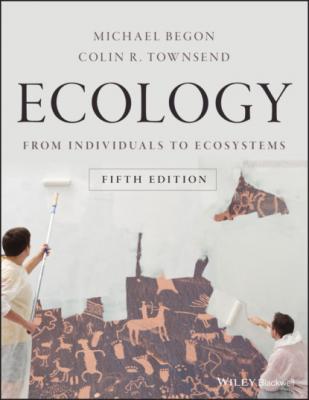Ecology. Michael Begon
Читать онлайн.| Название | Ecology |
|---|---|
| Автор произведения | Michael Begon |
| Жанр | Биология |
| Серия | |
| Издательство | Биология |
| Год выпуска | 0 |
| isbn | 9781119279310 |
6 Chapter 6Figure 6.1 The movements of locusts and their impending threat. An example f...Figure 6.2 Variation in physical and biotic variables in the Santuit River, ...Figure 6.3 The optimal location of nature reserves for giant pandas in China...Figure 6.4 The ‘seed rains’ of four tree species from a temperate rainforest...Figure 6.5 Predicting an outbreak of bluetongue virus. Results from the mode...Figure 6.6 Seed dispersal by frugivores can show a variety of patterns. The ...Figure 6.7 Birds and moths reflect contrasting combinations of active and pa...Figure 6.8 Phalanx‐type plants aggregate locally and co‐occur little with ot...Figure 6.9 Three generalised spatial patterns that may be exhibited by organ...Figure 6.10 The ‘grain’ of the environment must be seen from the perspective...Figure 6.11 Group living protects against predation in the chestnut‐crowned ...Figure 6.12 Inbreeding and outbreeding depression in Delphinium nelsonii. (a...Figure 6.13 Kin competition may drive offspring away from their natal habita...Figure 6.14 Density‐dependent emigration in spiders and mites. In labo...Figure 6.15 Plants staying at home in bad years and dispersing in good years...Figure 6.16 Dispersal polymorphisms. (a) The mean proportion (± SE) of winge...Figure 6.17 The proportion of male‐biased as opposed to female‐biased disper...Figure 6.18 The rapid spread of the western corn rootworm, Diabrotica virgif...Figure 6.19 Dispersal drives the local distribution of a sand‐dune plant....Figure 6.20 Flying squirrels in Finland preferentially occupy habitat favour...Figure 6.21 The predictable dispersal of zebra mussels, invading the USA. (a...Figure 6.22 Invasion of the giant hogweed. The changing distribution over ti...Figure 6.23 Butterflies tend to occupy the largest, least isolated habitat p...Figure 6.24 Identifying priority North American butterfly species for conser...Figure 6.25 The spatial structure of a metapopulation affects its overall ab...Figure 6.26 Applications of species distribution modelling. (a) Ecological niche mo...Figure 6.27 Many subpopulations of a bee metapopulation go extinct from year...Figure 6.28 Mainland–island metapopulations of a butterfly with contrasting ...Figure 6.29 A plant metapopulation. (a) Locations of the subpopulations, on ...Figure 6.30 Hanski’s metapopulation of the Glanville fritillary. (a) M...Figure 6.31 Alternative stable states for the Glanville fritillary metapopul...Figure 6.32 Genetic effects on the dynamics of the Glanville fritillary meta...Figure 6.33 Contractions in the ranges of four bird species that have especi...Figure 6.34 The changing distribution of the giant panda in China that will ...
7 Chapter 7Figure 7.1 Studies of selection show a tendency for larger body size to be f...Figure 7.2 Allocations of dry matter and nitrogen to the parts of a plant va...Figure 7.3 Reproductive value generally rises and then falls with age. (a) T...Figure 7.4 Life history trade‐offs demonstrate the costs of reproduction....Figure 7.5 The ‘Y model’ of de Jong and van Noordwijk ( 1992). T...Figure 7.6 Snakes that produced larger litters also recovered quicker from r...Figure 7.7 A trade‐off between growth and survival in sticklebacks. Su...Figure 7.8 Trade‐offs between the number of offspring produced in a clutch b...Figure 7.9 Crop plant species differ in the relative responses of seed numbe...Figure 7.10 Options sets and fitness contours together determining optimal l...Figure 7.11 Optimal life histories in high and low cost of reproduction habi...Figure 7.12 Proposed and observed patterns in reproductive allocation as ind...Figure 7.13 Effects of predation risk on patterns of reproduction in killifi...Figure 7.14 The ‘degree’ of semelparity in the plant Lobelia inflata depends...Figure 7.15 The optimisation of offspring size and number in a clutch or lit...Figure 7.16 Guppies produce fewer, larger offspring in a more highly competi...Figure 7.17 The optimisation of offspring size and number in a clutch or lit...Figure 7.18 Recruitment from great tit, Parus major, nests is highest from n...Figure 7.19 Evidence for an intermediate, Lack clutch (litter) size in lynx,...Figure 7.20 Evidence for r‐ and K‐selection in dandelions. Resul...Figure 7.21 A fast–slow continuum explains life history variation in plants,...Figure 7.22 A fast–slow continuum explains life history variation in mammals...Figure 7.23 The fast–slow continuum can help guide conservation priorities i...Figure 7.24 Grime’s CSR triangle as an organising principle for plant life h...Figure 7.25 Grime’s CSR triangle and dark diversity as a guide to conserving...Figure 7.26 Allometric life history relationships, all plotted on log scales...Figure 7.27 Allometric relationships between total clutch volume and body vo...Figure 7.28 Phylogenetic comparative methods, taking
